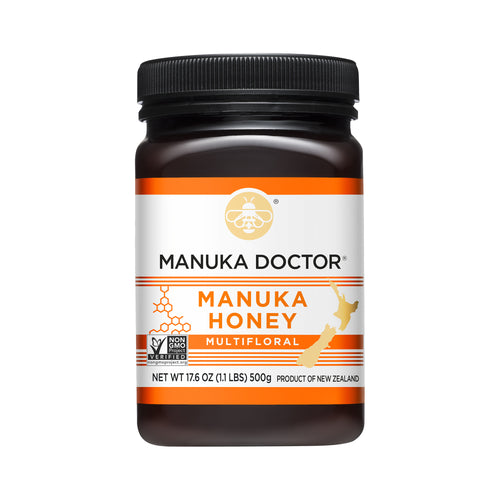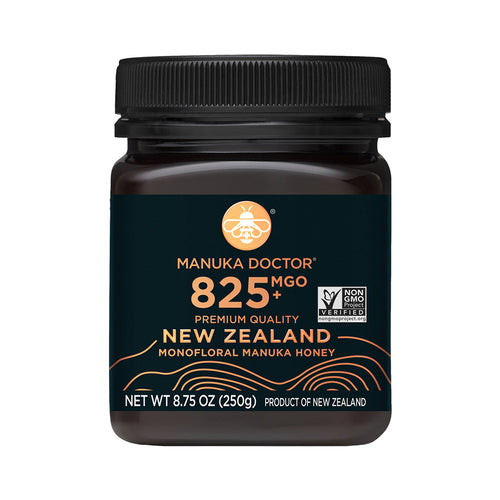Read Time: 4 minutes
Summary:
Not all Manuka honey is created equal—and knowing what to look for can help you choose the best. Genuine Manuka comes only from New Zealand and should be tested for both MGO levels and the government’s MPI standard. Top-quality brands, like Manuka Doctor, pack their honey in New Zealand, provide transparent lab results, and avoid blending with lower-grade honey. With raw, GMO-free honey from their own hives and careful filtration and creaming processes, Manuka Doctor ensures a consistent, premium product in every jar.

Buying Manuka? Read This First
One of the questions we get asked a lot here at Manuka Doctor HQ is; “What brand of Manuka honey is the really the best to buy?”
Helpfully, with Manuka honey there are several important checks, proof-points, and watch outs which you should certainly look for when considering a purchase.
This blog covers all of the main elements that make up a top quality Manuka Honey brand. Including:
1) Where is it from?
Real Manuka honey can only come from New Zealand. The New Zealand Government has created a strict scientific definition of what constitutes Manuka honey. Meaning that all companies who wish to export Manuka out of New Zealand must subject their honey to a strict lab analysis.
These New Zealand Government tests are often called the MPI Standard, (standing for Ministry Of Primary Industries) and checks for the levels of 4 naturally occurring chemical markers in the honey, as well as a DNA test to prove it is from New Zealand.
What’s also worth checking is if a Manuka brand packs their jars in New Zealand too. This is important, as it prevents unscrupulous companies from exporting Manuka in giant metal drums and then blending or diluting them in a separate company before sale!
All Manuka Doctor honey meets the MPI Standard, which is stamped on the lid of every jar we produce. And all Manuka Doctor honey is packed in New Zealand.

2) How is it tested
Reputable brands use reputable labs. And if the brand is being fully transparent with you, they will happily let you see the test certificates that were issued for the batch you are buying.
There are two types of tests which are typically done on good quality honey.
One is for the MPI standard markers, and one for the level of MGO, or Methylgloyxal.
All Manuka Doctor honey is tested 5 times between the bee-keeper and sale. You are able to see the exact Lab Certificates given to your batch of honey.
3) How is it described
You can learn a lot from the label of a honey. Sometimes this may reveal that the Manuka you thought was a Genuine New Zealand product was actually packed in a totally different country. Or that the product you felt was genuine cannot provide any test certificates to prove it.
If a honey is described as being a Manuka blend, it may mean it has been mixed with other non-manuka honey and diluted. Certainly not what you want if you are paying top price!
Look for honey that states it is a product of New Zealand, and that it is packed in New Zealand too.
All Manuka Doctor honey is easily identifiable as “Tested and Certified” 100 per cent Genuine New Zealand manuka honey.
4) How is it reviewed and rated?
This is the real test of how good a brand is. Read the online reviews and ratings for the product you are about to buy to see what others think.
Manuka Doctor accepts all reviews on our website, and for some strengths of our most popular Manuka, you can see hundreds of real life reviews.
If you have a question about taste, consistency, quality, aroma, or pairings. Then it’s very likely someone has already answered this for you.
5) Is it raw and GMO Free?
Because Manuka Doctor's honey is only sourced from New Zealand countryside through our own beehives, it is raw and guaranteed to be free of genetically modified organisms (GMO free). Our honey is never pasteurised or treated with artificial ingredients or preservatives. We simply filter the honey lightly to remove any remaining wax before it is stirred to prevent crystallisation, and finally packed into the final jar for you to enjoy.

Manuka Doctor also runs great deals every month on a range of Manuka Honey strengths. You can see what’s currently on offer here.
Try a new Manuka recipe today!
Is Manuka Doctor’s honey filtered?
Often when Raw Manuka is extracted from the beehive it may contain wax, propolis and other debris left in the hives by the bees.
At Manuka Doctor we lightly filter our honey before it is packed to ensure that you receive the consistency that you expect which is free from any foreign objects being in your jar.

What does creamed mean?
Creaming means stirring and is a process of natural granulation of the honey.
It’s required because in its liquid form, natural sugars in any honey want to return to their solid state. This usually leads to unsightly (yet completely harmless) natural sugar crystals forming in honey over time. To avoid these crystals from forming, we lightly cream our honey.
Creamed honey is honey that has been stirred to control crystallisation. It gives the honey its smooth consistency and lighter colour than liquid honey of the same floral type.
And it means that when you open your jar of honey it is the same taste in the UK as it was when packed 11,000 miles away in New Zealand.
Some Manuka Honey may be un-creamed and this will have a more grainy texture. Un-creamed Manuka honey will usually have larger sugar crystals and may be harder in consistency as a result.

Some Manuka Honey says raw on the label but yours does not, why is this?
This is because of the Honey England Regulations 2015. A legal regulation which covers honey companies who operate within the UK.
It deems that all honey is classified as “raw” at the point it is harvested and it only becomes “not raw” if it is pasteurised, heat treated or otherwise processed to the point that its composition is changed.
A second UK regulation called the Food Information Regulations 2014 prohibits the use of descriptions which “suggest that a food possesses special characteristics when all foods of this type have the same characteristics”.
In other words, while Manuka Doctor honey meets all the criteria for being raw, it is not permitted to use this term on the label in the UK.
Any honey company who states raw on their label are working outside of these two legal guidelines.
Read more: Dr Fred's top 5 secret ingredients for good health, naturally




